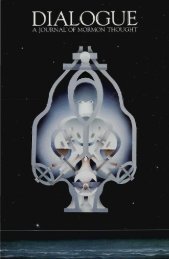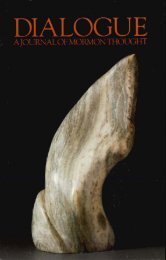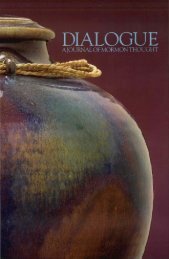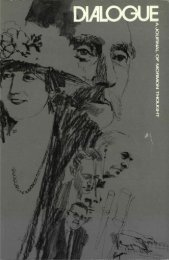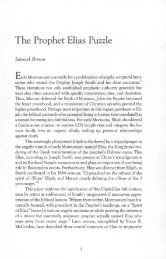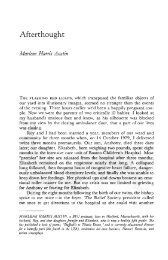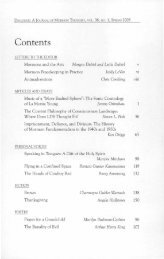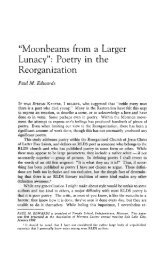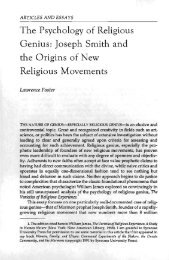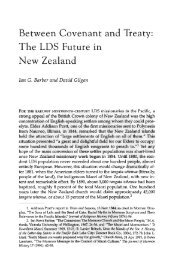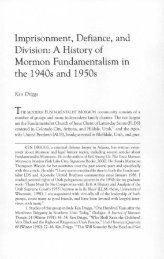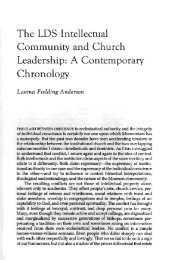Dialogue, Volume 25, Number 2 - Dialogue – A Journal of Mormon ...
Dialogue, Volume 25, Number 2 - Dialogue – A Journal of Mormon ...
Dialogue, Volume 25, Number 2 - Dialogue – A Journal of Mormon ...
Create successful ePaper yourself
Turn your PDF publications into a flip-book with our unique Google optimized e-Paper software.
REVIEWS 173<br />
words could be Terry's as well: "You do<br />
not die from being born, nor from having<br />
lived, nor from old age. You die from<br />
something. The knowledge that because <strong>of</strong><br />
her age my mother's life must soon come<br />
to an end did not lessen the horrible<br />
surprise. She had carcinoma. Cancer. My<br />
mother encouraged us to be optimistic.<br />
. . . She asserted the infinite value <strong>of</strong> each<br />
instant. . . . There is no such thing as a<br />
natural death" (1973, 123). And from<br />
Terry's mother, "Terry, to keep hoping for<br />
life in the midst <strong>of</strong> letting go is to rob me<br />
<strong>of</strong> the moment I am in" (p. 161). The emotional<br />
urgency in dying, the hard work it<br />
involves, is the subject <strong>of</strong> Refuge too.<br />
Terry is the one who cannot turn away,<br />
even from the horrors <strong>of</strong> unnatural death.<br />
She is the one who cannot lie. Ever. That,<br />
too, is more central than nature. Her<br />
words do not lie. She writes —not as a<br />
"watch me writing" writer, but as one who<br />
bears testimony <strong>of</strong> power in the accurate<br />
word, the telling metaphor, the informed<br />
story. This is her articulation <strong>of</strong> grief and<br />
sometimes <strong>of</strong> palpable written rage<br />
(though never rant). This book presents<br />
words and storyline as a way <strong>of</strong> communing<br />
with death — <strong>of</strong> doing something that<br />
most <strong>of</strong> us refuse to do —facing and rehearsing<br />
our own inevitable deaths. In his<br />
poem "Spring and Fall," Gerard Manley<br />
Hopkins suggests that even as we cry for<br />
what is dying, it is our own eventual<br />
deaths we mourn. The child Margaret<br />
cries, ostensibly over falling leaves —the<br />
death <strong>of</strong> a season, not knowing that she<br />
mourns her own relentless progression<br />
towards death. "Margaret are you grieving<br />
/ over Golden grove unleaving? . . . /<br />
Now, no matter, child, the name: / Sorrow<br />
springs are the same, . . . / It is the blight<br />
man was born for / It is Margaret you<br />
mourn for (1979, 86). Like Hopkins, Williams<br />
uses nature as image for human<br />
blight, plight, and sorrow —as reflective<br />
<strong>of</strong> self sorrow. "But this time I was not<br />
crying for Mother. I was crying for me. I<br />
wanted my life back. I wanted my marriage<br />
back. I wanted my own time. But<br />
most <strong>of</strong> all I wanted the suffering for<br />
Mother to end" (p. 164).<br />
And there's her singularly honest use<br />
<strong>of</strong> metaphor. Not only are her own metaphors<br />
good and true and revelatory, she<br />
also rejects metaphors that cloud or discolor<br />
our ways <strong>of</strong> seeing.<br />
This is cancer, my mother's process, not<br />
mine. . . . Cancer becomes a disease <strong>of</strong><br />
shame, one that encourages secrets and lies,<br />
to protect as well as to conceal.<br />
And then suddenly, within the rooms<br />
<strong>of</strong> secrecy, patient, doctor, and family find<br />
themselves engaged in war. Once again<br />
medical language is loaded, this time with<br />
military metaphors: the fight, the battle,<br />
enemy infiltration, and defense strategies.<br />
I wonder if this kind <strong>of</strong> aggression waged<br />
against our own bodies is counterproductive<br />
to healing. Can we be at war with ourselves<br />
and still find peace? (p. 43)<br />
How can this book not be about nature<br />
when its very anatomy turns on bird<br />
names and precise lake levels? The chapter<br />
titles read as a taxonomy <strong>of</strong> water<br />
birds, with subheads giving measurements<br />
<strong>of</strong> the levels <strong>of</strong> the Great Salt Lake,<br />
levels crucial for the existence <strong>of</strong> these<br />
birds' refuge and habitat. Bird imagery<br />
here turns on human plight. Birds are the<br />
perfect metaphor — they "who mediate between<br />
heaven and earth" (p. 95). "There<br />
are those birds you gauge your life by"<br />
(p. 8). The birds' almost weightless bodies<br />
present poignant image <strong>of</strong> "the unbearable<br />
lightness <strong>of</strong> being" that Diane Tempest<br />
moves painfully toward. Starving and<br />
emaciated at the end, she becomes as Isak<br />
Dinesen envisioned her frail self: "And by<br />
the time I had nothing left, I myself was<br />
the lightest thing <strong>of</strong> all, for fate to get rid<br />
<strong>of</strong>" (in Thurman 1982, 443).<br />
I must cite the strong image <strong>of</strong> the<br />
dead swan, taking it as just one example<br />
<strong>of</strong> how skillfully woven is this tapestry <strong>of</strong><br />
birds and life and death; <strong>of</strong> water, sand,<br />
and sky. Here is the writer planting symbol,<br />
a prefiguration <strong>of</strong> how she will dress<br />
and care for her own mother's body:<br />
Small waves hissed each time they broke<br />
on shore. Up ahead, I noticed a large, white<br />
mound a few feet from where the lake was<br />
breaking.



